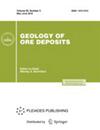俄罗斯核工业的矿产资源和放射性废物的隔离
IF 0.6
4区 地球科学
Q3 GEOLOGY
引用次数: 1
摘要
本文考虑了确保俄罗斯核工业可持续发展所需的任务,这些任务旨在解决核燃料循环的初始和最终阶段的问题,从铀矿资源基地的再生产到乏核燃料后处理的液体高放废物的处理。结合核发电厂发电的预测增长,分析了矿物资源综合体的发展趋势。在目前预测和成矿研究的框架内,以外贝加尔东南部领土为例,提出了根据铀矿床矿物形成系统模型,利用遥感数据、地理信息系统模型和神经网络技术来分配和确定找矿区的新方法。详细分析了解决核燃料循环后端问题的发展趋势。提出了利用磷玻璃陶瓷和独居石对高放废物中的稀土-锕系元素部分进行分离和后续处理。本文章由计算机程序翻译,如有差异,请以英文原文为准。

Mineral Resources of the Russian Nuclear Industry and Isolation of Radioactive Waste
Abstract This article considers tasks needed to ensure sustainable development of the Russian nuclear industry, which are aimed for solving the problems of the initial and final stages of the nuclear fuel cycle, from reproduction of the uranium mineral-resource base to handling of liquid high-level waste of spent nuclear fuel reprocessing. The trends in the development of the mineral-resource complex are analyzed in connection with the projected growth of electricity generation at nuclear power plants. New approaches to the allocation and substantiation of prospecting areas based on the models of mineral-forming systems of uranium deposits using remote-sensing data, GIS modeling, and neural-network technologies are proposed on the example of the territory of southeastern Transbaikal within the framework of current prognostic and mineragenic studies. A detailed analysis of trends in solving the problems of the back end stage of the nuclear fuel cycle is carried out. The use of phosphate glass ceramics with monazite is proposed for isolation and subsequent disposal of the REE–actinide fraction of high-level waste.
求助全文
通过发布文献求助,成功后即可免费获取论文全文。
去求助
来源期刊

Geology of Ore Deposits
地学-地质学
CiteScore
1.10
自引率
14.30%
发文量
24
审稿时长
6-12 weeks
期刊介绍:
Geology of Ore Deposits is a periodical covering the topic of metallic and nonmetallic mineral deposits, their formation conditions, and spatial and temporal distribution. The journal publishes original scientific articles and reviews on a wide range of problems in theoretical and applied geology. The journal focuses on the following problems: deep geological structure and geodynamic environment of ore formation; distribution pattern of metallogenic zones and mineral deposits; geology and formation environment of large and unique metallic and nonmetallic deposits; mineralogy of metallic and nonmetallic deposits; physicochemical and isotopic characteristics and geochemical environment of ore deposition; evolution of ore-forming systems; radiogeology and radioecology, economic problems in exploring, developing, and mining of ore commodities.
 求助内容:
求助内容: 应助结果提醒方式:
应助结果提醒方式:


